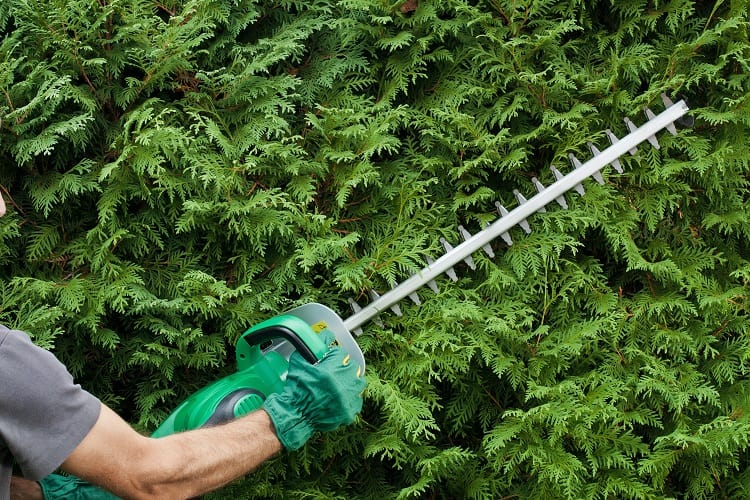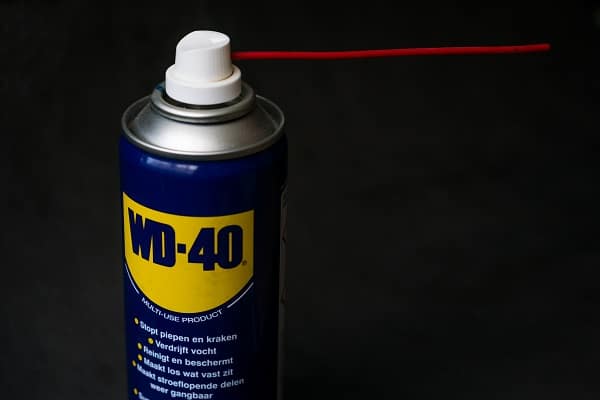Hedges are a great shrub to plant in front of your house to provide curb appeal. And they don’t require a lot of maintenance, besides being trimmed using a hedge trimmer.
You can use an electric hedge trimmer after the rain, but there are some safety precautions to be aware of. You should use a battery-operated trimmer to lower the risk of electrocution, wear gloves with a firm grip so that the trimmer doesn’t slip, and lubricate the trimmer blade to prevent rust.
We’re going to discuss everything you need to know about using an electric hedge trimmer after the rain to cut your shrubs. Here we go!
What Are Electric Hedge Trimmers?

Electric hedge trimmers are a gardening tool that runs on a battery or electrical cord. These devices have a blade that cuts through the sturdy branches of shrubs and small bushes. If you’re new to hedge trimming, check out this excellent instructional video.
You can find hedge trimmers from a smaller hand-held version with a 4″ to 6″ blade up to a full-size trimmer with a single blade between 16 inches and 26 inches.
Some blades are dual-action, which means they have less vibration and can cut from both sides of the blade. A single action or single-sided trimmer only has one sharpened side, so you’re limited in how you can make cuts.
You’ll also want to consider the spacing between the blade’s teeth, as this controls how thick of a branch the trimmer will cut. You can find electric hedge trimmers that can cut up to a ¾” diameter.
How to Use an Electric Hedge Trimmer After the Rain
If you’re going to use an electric hedge trimmer after the rain, you need to use caution, so you don’t get electrocuted.
If you’re using a corded electric trimmer, make sure that no water can get to the plug, as this can cause the product to short out. With battery trimmers, the electrocution risk is lower.
Trimming wet shrubs can be more complicated than trimming dry bushes as the branches get soft and bendy when they’re wet. Wet sticks are harder to break than when the bark is tough and dry.
Safety Tips for Using a Hedge Trimmer After the Rain
It would be best if you always used safety precautions when using hedge trimmers, especially after the rain. Because wet shrubs are harder to cut, the branches can break into small pieces of wood that can cause injury.
Dress for Safety
You should always wear clothing that covers your arms and legs, such as pants and a long sleeve shirt. Small pieces of wood can cause injury to your skin.
It’s also advisable to wear appropriate eye protection. You can end up with dirt, pieces of wood, or other debris into your eyes, which could be dangerous when you’re handling sharp objects.
Gloves will help you keep your grip if the handle gets slippery. It would also help if you always used both hands when cutting in wet conditions.
You’ll also want to cover your feet with tennis shoes or boots that have excellent traction, so you don’t risk slipping in the wet ground.
Keep Your Blade in Good Condition
Cutting wet shrubs is difficult enough without adding the complication of dull blades. When your blade is dull, the teeth lose traction as they slide across the wet branches.
This results in wood that bends or cracks without completely cutting the branch in half.
To sharpen your blade, you can use a hedge trimmer sharpener like a bastard file, an angle grinder, or even a rotary tool like a Dremel (link to Amazon).
Here’s a helpful video that walks you through the steps of sharpening your blades.
Trying to cut your wet shrubs with a dull blade can cause your shrubs to look ragged and damaged. It can also cause damage to your blade, with the teeth bending or breaking off. You would have to replace the blade, meaning extra money out of your pocket.
Lube Your Blade

One of the problems that can occur from trimming hedges after the rain is that water can cause the blade to rust. The water can also get into the sensitive inner workings of the trimmer, damaging the gears.
If you don’t protect your blade from water, it can reduce mobility. This loss of movement causes the blade not to cut as well as it should.
You can lubricate your hedge trimmer blades using a spray application or applying a light layer of machine oil using a dry rag. After each use of your trimmers, clean the blade thoroughly, and then cover with lubrication.
Avoid Rust
To keep your electric hedge trimmers in optimal working order, it’s essential to keep your blade from getting rusty. When a blade gets rusty, it can end up seizing completely.
If you want to prevent rust on your blade, it’s crucial to wipe off any remaining water and apply rust preventative—metal oxidizes when it gets wet, which eventually results in rust.
After you’ve trimmed your wet hedges, use a dry cloth to wipe down the entire blade. Place the trimmer in the sun to dry. Then apply lubrication before putting the trimmer away.
If your blade shows signs of rust or seizing, you can coat your blade with WD-40 or kroil oil. These products break down any rust build-up and provide lubrication to ease movement.
How to Clean Your Electric Hedge Trimmers
Your trimmers should be kept clean if you want them to work correctly. Trying to trim wet hedges can cause your blade to get dirtier than when you’re trimming dry branches.
This happens because the water makes debris easier to stick to the surface of the blade. It’s essential to clean your hedge trimmers after each use, making sure to remove any water or material on the sides and between the teeth.
Cleaning your electric hedge trimmers is pretty simple. All you need is a washcloth, warm soapy water, and a small scrubbing brush or a toothbrush.
- Soak the rag with the soapy water.
- Hold the trimmer with the blade pointed to the ground and wipe one side.
- Use the scrubbing brush to clean between the teeth and around the base and tip.
- Wipe again.
- Flip to the other side of the blade and repeat the process.
- Rinse out the rag and wipe down both sides of the blade.
- Be sure to remove any water droplets off the blade.
- Let the trimmer dry in the sun for ten to twenty minutes.
- Apply a light coat of lubrication and put away.
If you’re using your hedge trimmer on plants infected with a fungal disease, you will want to disinfect the blade using alcohol or kerosene. You can apply these sterilizations utilizing a rag or alcohol pads. But generally, soap and water are enough to clean your trimmer blade.
Final Thoughts
When used correctly, electric hedge trimmers can be used to trim your shrubs after the rain. To be safe, you should follow the precautions mentioned so you don’t end up injuring yourself, your shrubs, or your equipment.
Always wear the appropriate safety gear and keep your electric hedge trimmer in optimal working order by keeping the blade clean, dry, lubricated, and sharpened.
While it is safe to use an electric hedge trimmer after the rain, you should never try to operate one while the storm is happening, as you increase the risk of electrical shock.

